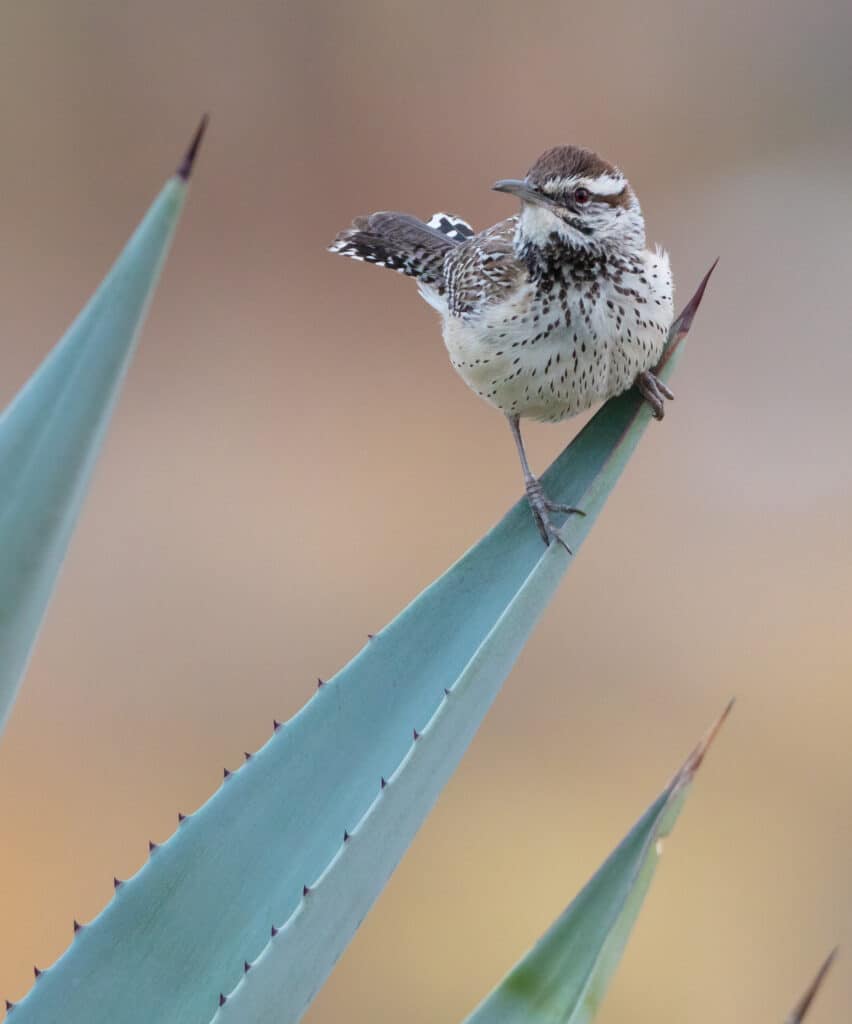Cactus Wren
Campylorhynchus Brunneicapillus
It is the largest wren in the United States
Advertisement
Cactus Wren Scientific Classification
- Kingdom
- Animalia
- Phylum
- Chordata
- Class
- Aves
- Order
- Passeriformes
- Family
- Troglodytidae
- Genus
- Campylorhynchus
- Scientific Name
- Campylorhynchus Brunneicapillus
Read our Complete Guide to Classification of Animals.
Cactus Wren Conservation Status
Cactus Wren Facts
- Prey
- Spiders, insects, small reptiles, and plant matter
- Main Prey
- insects
- Name Of Young
- Chicks
- Group Behavior
- Family units
- Pair
- Fun Fact
- It is the largest wren in the United States
- Estimated Population Size
- 8.5 million
- Biggest Threat
- Climate change
- Most Distinctive Feature
- Raspy, mechanic-sounding calls
- Wingspan
- 11 inches
- Incubation Period
- 16 to 17 days
- Age Of Independence
- 30 to 50 days
- Age Of Fledgling
- 19 to 23 days
- Habitat
- Arid and semi-desert regions
- Diet for this Fish
- Insectivore
- Lifestyle
- Diurnal
- Number Of Species
- 7
- Location
- United States and Mexico
- Average Clutch Size
- 4
- Nesting Location
- Desert vegetation surrounded by thorns
View all of the Cactus Wren images!
“Their raspy song sounds like a car engine that won’t start.”
If you’ve ever taken a hike through a desert trail in the Southwestern United States, you may have had a scratchy, mechanical serenade. The cactus wren is a staple in these desert environments, whether perched on cacti or hopping around on the dry, dusty ground. These desert birds are adequately adapted to live in harsh environments; discover everything that makes the cactus wren unique!
5 Amazing Cactus Wren Facts
- The cactus wren is non-migratory and establishes permanent residencies.
- They build football-shaped nests to deter predators.
- It is the largest wren in the United States, growing 7.5 inches long.
- It will eat dead insects off of cars.
- They form permanent pair bonds for life.
Where to Find the Cactus Wren
The cactus wren is only in the United States and Mexico. You can find it in six states, including California, Nevada, Arizona, Utah, New Mexico, and Texas. In Mexico, it inhabits Sonora, Sinaloa, Chihuahua, Coahuila, Hidalgo, Nuevo León, and Baja California. This bird lives in arid and semi-desert regions, which include the Sonoran and Chihuahuan deserts. They are non-migratory and establish permanent territories, unwilling to leave even during seasonal changes. Further, they are exceptionally territorial and will defend their habitats with vigor, loudly proclaiming when you’ve overstepped the boundary.
This wren lives in a variety of low, dry habitats, mainly deserts with thorny shrubs and cacti. Their favorite is the cholla cactus, mesquite brush, and yucca. You will most likely see them in pairs or families, hopping in brush or parading on the ground.
Cactus Wren Nest
Females pick out the nesting spot, and males join in with the building. You can find their nests three to 10 feet above the ground in desert vegetation like cholla cacti, acacia, and mesquite, surrounded by thorns. The nest is football-shaped with tunnel entrances, and the duo uses grass and plant fiber to structure it. It’s typically seven inches in diameter and 12 inches long, weighing about six ounces. Its unique shape is designed to be just big enough for them to squeeze through but small enough to keep predators out. They line the inside of their nest with feathers, making it a soft, comfortable, and secure place to hatch chicks.
Scientific Name
The cactus wren’s (Campylorhynchus Brunneicapillus) genus is Campylorhynchus, which is Greek for “curved beak,” and its byname brunneicapillus translates to “brown hair.” Its common name describes its propensity for perching, nesting, and hiding in various cacti in desert habitats. There are several subspecies of cactus wren but scientists generally only recognize seven; all of them fall within its preferred range in North America.
Size, Appearance, and Behavior
As the largest wren in the United States, it is between 7.1 and 7.5 inches long, weighs 1.18 to 1.65 ounces, and a wingspan of 11 inches. This chunky bird has a long, sturdy beak, a long, rounded tail, and short, rounded wings. Its bill curves slightly downwards and is about the same size as its head. The cactus wren has an overall brown color with white and black specks, with distinctive long, white eyebrows. Males and females look alike, but juveniles are paler with brown eyes instead of red.
Most wrens are shy and like to hide in vegetation, but cactus wren are social, loud, unbothered creatures. They always make their presence known out in the open, loudly calling and fanning their tail feathers. This species is adaptable and curious, always exploring new food sources, even picking dead insects off of cars. They are not strong flyers, so you will most likely see them hopping on the ground or low shrubs foraging for food.

Cactus wrens are between 7.1 and 7.5 inches long, and weigh 1.18 to 1.65 ounces.
©Melinda Fawver/Shutterstock.com
Diet
The cactus wren is primarily an insectivore, but as a curious forager, it will try many things.
What Does a Cactus Wren Eat?
The cactus wren mainly eats spiders and insects, such as ants, wasps, beetles, butterflies, and grasshoppers; It will occasionally eat small reptiles like lizards. Around 20% of their diet comes from plant material, like berries, seeds, nectar, and cactus fruits. As a desert species, this wren rarely drinks free-standing water. Instead, it receives most of its hydration from the food it consumes, primarily cactus fruit and sap. The cactus wren feeds its chicks a diet of whole insects, typically grasshoppers.
Predators, Threats, and Conservation Status
The IUCN list the cactus wren as “least concern,” meaning it has a large range and does not approach the criterion for a threatened species. However, its population is declining, though not significantly, and it faces possible future issues from climate change. The cactus wren may be particularly sensitive to drought, wildfires, and spring heat waves. Extreme heat and drought affect their young and can cause food shortages, and wildfires have the potential to ruin their habitats.
What Eats the Cactus Wren?
Like most birds, the cactus wren must deal with anything larger with claws and teeth. Its predators include hawks, coyotes, foxes, bobcats, and domestic cats. Their football nests are to protect them and their young.
Reproduction, Young, and Molting
Cactus wrens establish monogamous pair bonds, and the couple defends their year-round home together. Their interactions are unique. They give each other a greeting ceremony, where they spread their wings and give a harsh call. Egg laying occurs 18 days after copulation, and the males create “dummy” nests when the female is incubating.
They typically lay three to four eggs, and incubation takes 16 days (solely by the females). Wrens may destroy eggs from nearby nests but are not known for brood parasitism. Once hatched, both parents feed the nestlings, and the young leave around 19 to 23 days after hatching. However, they will remain in their parent’s territory until they are between 30 and 50 days old.
Population
The cactus wren’s global population is 8.5 million mature individuals. This species has a downward trending population, with an average decline rate of 2.1% per year (from 1970 to 2017). However, short-trend data indicate their numbers have declined by 19% over the past decade. Some studies indicate they may need supplemental food to increase reproductive success.
Up Next:
View all 235 animals that start with CCactus Wren FAQs (Frequently Asked Questions)
Does the cactus wren migrate?
No. The cactus wren establishes permanent territories.
How many eggs does the cactus wren lay?
They lay between 2 and 7, with an average of 3 or 4.
How fast does the cactus wren fly?
It is unknown how fast they fly. But they aren’t solid flyers and choose to spend their time on the ground or in low vegetation.
What is the cactus wren's wingspan?
Their wings average 11 inches long.
When do cactus wren leave the nest?
Chicks leave the nest 19 to 23 days after hatching, but they stay near their parent’s territory for a while.
Why is it called a cactus wren?
This species prefers to perch and nest on cacti, preferably cholla cacti.
Is the cactus wren endangered?
The cactus wren has a “least concern” status from IUCN, but their population is steadily declining.
Thank you for reading! Have some feedback for us? Contact the AZ Animals editorial team.
Sources
- IUCN Red List / Accessed September 2, 2022
- JSTOR / Accessed September 2, 2022
- San Diego Management & Monitoring Program / Accessed September 2, 2022
- Sabino Naturalists / Accessed September 2, 2022
- Conservation Evidence / Accessed September 2, 2022


















